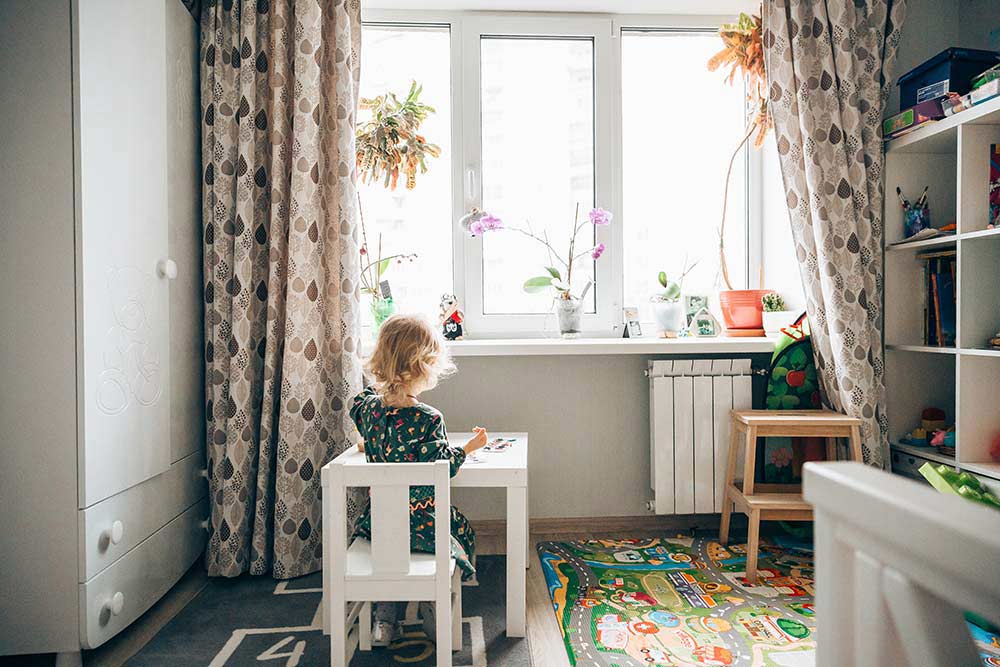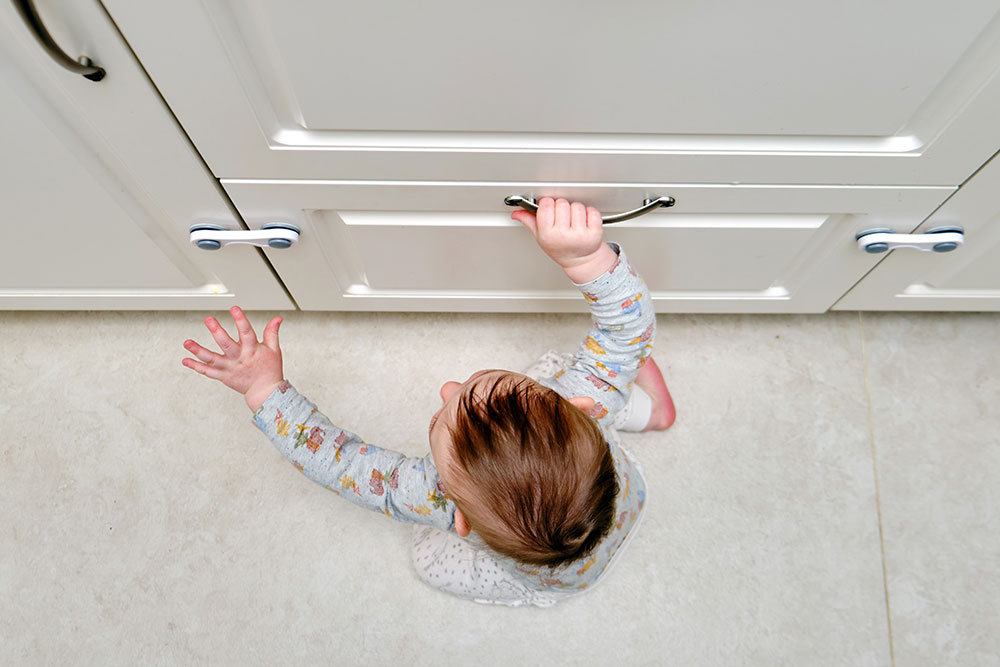Why Furniture Safety Straps and Child-Proofing Are Non-Negotiable

More than 11,500 kids were treated for furniture or television tip-over injuries in 2019, so just as you would install baby gates, cabinet locks, and outlet covers, securing furniture should be a top priority.
Experts: Kimberly Amato; Karla Crosswhite-Chigbue
After enduring the unimaginable and heartbreaking loss of her young daughter in 2004, Kimberly Amato created Meghan’s Hope and became a founding member and vice chair of Parents Against Tip-Overs. Her goal was and continues to be clear: to educate people on furniture safety and spare families from the kind of tragedy she experienced.
In the early morning hours of December 18, 2004, Amato woke up to discover her 3-year-old daughter, Meghan, had passed away after her dresser tipped over on top of her during the night. Neither she, her husband, Meghan’s twin brother, nor her 6-year-old brother heard the accident happen.
It’s a tragic, devastating story; unfortunately, the Amato family is not alone. According to the 2022 Tip-Over Report from the U.S. Consumer Product Safety Commission (CPSC) published in February 2023, 482 children under the age of 18 died from a tip-over from 2000 to 2021. It’s a staggering number that can leave families feeling helpless. Thankfully, with a little money and a little time, furniture and televisions can be secured in a way that can (and does) save lives.
“Instead of putting a few holes in our walls and furniture, we forever have one in our hearts that will never heal,” Amato says. “Walls can be fixed, broken hearts cannot.”
The Research and Regulations Surrounding Tip-Over Injuries
Researchers at the Center for Injury Research and Policy at Nationwide Children’s Hospital in Columbus, Ohio, published a study in 2021 that found that between 1990 and 2019, an estimated 560,200 children were treated in US emergency departments for injuries related to furniture or television tip-overs. Young children are overwhelmingly impacted by tip-overs (70% of injuries happen to those under 6 years old), and nearly 60% of injuries are caused by TVs or clothing storage units (CSUs) like dressers.
So what’s being done about it? In July 2021, the CPSC proposed a rule addressing the weaknesses in existing voluntary safety standards for furniture manufacturers, specifically drawing attention to the fact that tests to meet these standards are lacking. In December of 2022, the Stop Tip-overs of Unstable, Risky Dressers on Youth (STURDY) Act was signed into law, which has strengthened safety standards and made them mandatory. The final version of the law went into effect on September 1, 2023, and requires manufacturers to test clothing storage units with simulations of children weighing up to 60 pounds and with real-world use in mind—including “impact on clothing storage unit stability that may result from placement on carpeted surfaces, drawers with items in them, multiple open drawers, and dynamic force.”
Additionally, manufacturers must provide furniture anchoring kits with these products, and any new furniture made after September 1, 2023, a retailer sells must meet these new requirements. However, it’s important to note that this law only applies to new furniture manufactured from September 1 forward, and furniture made before this date can still be sold.
What Are the Benefits of Installing Anti-Tip Straps?
Even armed with the research, you may have misconceptions that lead you to believe securing furniture doesn’t need to be a priority. Amato says she often talks to people who are certain a tip-over accident will never happen to them and that their furniture is stable enough. “It doesn’t matter how tall your furniture is, how heavy it is, how wide it is, how much you paid for it,” Amato says. “None of that matters because what causes furniture to tip over is physics.”
Or, she says, parents are sure their child won’t climb, but she reminds them that play is the work of children. “Developmentally, they’re doing what they’re supposed to do. They’re exploring their environment.”
Even if you watch your child very closely, no parent can have eyes on their child every moment of the day, says the American Academy of Pediatrics (AAP). Especially since around 50% of fatalities involving children happen in bedrooms, often when parents think their kids are asleep. “That’s why it is critical to make your home environment as safe as possible,” the AAP says. Plus, the CPSC’s “Even When You’re Watching” campaign video shows actual footage of just how quickly a tip-over can happen.
How To Anchor Furniture for Kids
Existing furniture should be anchored even if your child is only an infant, and any new pieces should be anchored as soon as they are assembled and put in place. Use furniture safety straps or L-brackets to anchor dressers, bookcases, entertainment centers, televisions, and other furniture to the wall. Remember that heavier furniture requires more anchors. Even if they are more expensive, use metal, name-brand anchoring products like HangMan and Safety 1st. Fabric straps can tear, and plastic ones can become brittle and break. Be wary of cheaper options with names you don’t recognize. Amato points out that there aren’t mandatory standards for anchors, so knockoffs fail more often and give families a false sense of security.
Keep in mind that you may have to move furniture pieces so they are against a wall and aligned with studs, which means the dresser may not be perfectly centered along the bedroom wall. If your walls are made of brick or concrete, or if they have metal studs, talk to your hardware store to make sure you have the right products and tools you need.
Keep furniture clear of anything that might grab your child’s interest (think toys, books, remote controls, food, etc.) and cause them to climb. You should also try to keep heavy items close to the floor. For example, place your hardcovers on the bottom bookshelf and paperbacks up top.
If you don’t feel comfortable securing furniture on your own, childproofers can assess your home and/or install anchors. Amato also suggests having a childproofing party. “Have all your friends over, get pizza and beer to have after you’ve finished babyproofing, and then next time, go to their house!”
Securing Televisions
Televisions should be mounted to the wall when possible. If your TV is placed on a surface, only use furniture specifically designed to hold TVs (an entertainment stand, not a table) and TVs of your size. Both the stand and your TV should then be anchored to your wall. Once everything is secured, tuck cords away so they don’t become a tripping hazard.
Old tube TVs should be recycled whenever possible. Some big box stores will even do that for you. Amato says a big misconception is that flat screens are so light that they won’t hurt anyone if they tip. “A light flat screen can weigh 10 pounds,” she says. “And you wouldn’t drop a 10-pound bowling ball on your child’s head.”

Securing Dressers
Install drawer stops or safety straps so your child can’t open them fully. If you use ones with a magnetic drawer lock, store the key in a safe place out of your child’s sight and reach. If you are convinced your dresser is sturdy enough on its own, Amato says you can test it by opening all the drawers. “On the top, with two fingers, press down gradually in the middle to see how hard it is,” she says. “You might be surprised.”
Securing Furniture in Other Locations
It’s just as important that family members’ houses have anchored furniture, too. Amato knows that many grandparents will put up a fight: “After all, you survived!” However, she encourages families to talk to their loved ones, daycare providers, and vacation rental hosts to make sure the areas are childproofed and the furniture is secure.
She knows that anchoring furniture can be especially difficult for renters as it may cost them their security deposit. “A lot of landlords are just unaware,” she says. “Go to them and present the information, offer to patch the holes when you leave, and tell them that this is a matter of safety for your children.”
In the Case of a Tip-Over Injury
Immediately take your child to their pediatrician or the emergency room. “Even if they seem fine, there could be internal bleeding or damage to their organs,” the AAP says. It’s also important to report tip-overs to the CPSC even if your child wasn’t injured. This could help prevent future injuries or fatalities from the same type of furniture. “When we find specific models that are defective, we work to recall them,” CPSC spokesperson Karla Crosswhite-Chigbue says. “Getting them off store shelves and out of consumer’s homes.” Regardless of whether a recall happens, Amato says parents can use the site as a resource when researching furniture to see if any complaints have been filed.
For more information and videos on how to install anti-tip devices, visit AnchorIt!, an educational campaign from the CSPC. To get involved and find support, visit Parents Against Tip-Overs.







